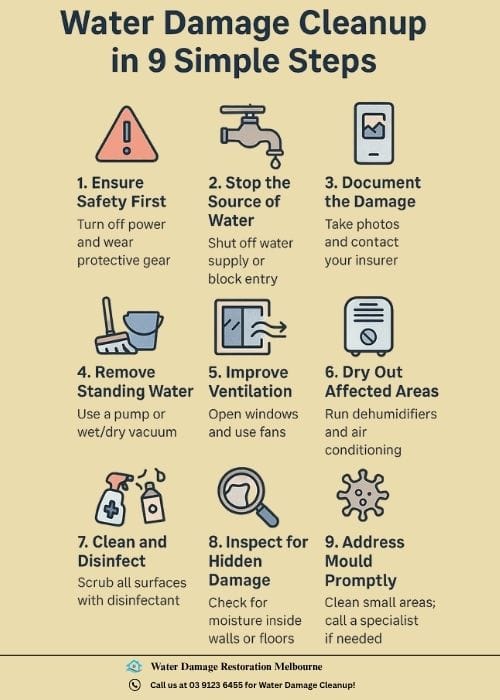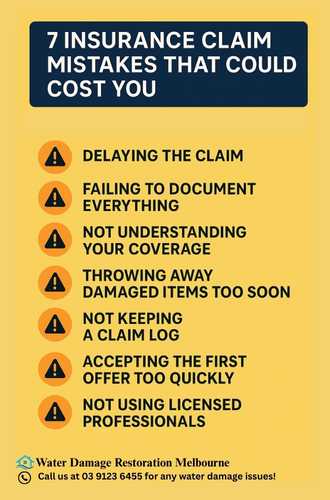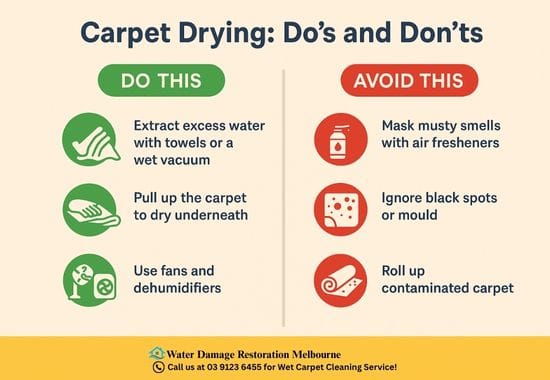At Water Damage Restoration Melbourne, we’ve helped hundreds of local families across Melbourne deal with water and flood damage quickly, safely, and properly. Our trained team knows what works and what doesn’t, and we’re available 24/7 if things go beyond DIY.
In this guide, we’ll walk you through everything you need to know, from stopping the water to drying your carpets, cleaning mould, and preventing future damage. You’ll also find tips for your insurance and know when it’s time to call a professional. Let’s get started.
Table of Contents
ToggleKey Takeaways:
- Act quickly: Begin cleanup within 24 hours to prevent mould, contamination, and structural damage.
- Prioritise safety: Turn off power at the circuit breaker and wear protective gear before touching anything.
- Stop the water source: Shut off the main water supply or block rain entry if it’s a roof or storm issue.
- Document everything: Take photos, list damaged items, and contact your insurance provider right away.
- Remove standing water: Use buckets, a wet/dry vacuum, or a sump pump, depending on the volume.
- Ventilate and dry: Open windows, run fans, dehumidifiers, and your air conditioning to accelerate drying.
- Clean and disinfect: Use hot, soapy water and disinfectants to sanitise all hard surfaces.
- Inspect thoroughly: Look for bulging plaster, peeling paint, or musty smells — signs of hidden moisture.
- Address mould fast: Clean small patches yourself, but call a mould remediation specialist if it spreads.
- Prevent future damage: Install leak detectors, maintain drainage, and know where your shut-off valve is.
How Do You Stop a Leak and Stay Safe During a Water Damage Emergency?

First things first—safety. If you have water coming in, try to find the source:
- Turn off the main source of the water supply if a pipe has burst or if an appliance like a washing machine, dishwasher, or hot water system is leaking to prevent further damage.
- For roof leaks or heavy rain intrusion, place buckets under the leak to catch dripping water and use towels to soak up any that spreads across the floor.
- If water is near outlets or appliances, immediately switch off power at the circuit breaker to prevent electrical hazards. Never touch wet electrical components, always wait for a licensed electrician to assess the situation.
Next, grab personal protective gear such as gloves, rubber boots, and even a mask if the water looks dirty or smells bad. Floodwater may be contaminated, and exposure can lead to serious contamination risks, especially from sewage or chemicals.
What Should I Document for My Insurance After Water or Flood Damage?
Before dealing with water damage, grab your phone and take clear photos and videos of the damage—floorings, walls, furniture, everything.
Also:
- Write a list of damaged items that are affected by water damage.
- Keep receipts for anything you buy to fix the problem (like fans or cleaning supplies).
- Contact your insurer ASAP and ask about your coverage for water damage.
Tip: Not all home insurance covers flooding. Always check your policy or ask your agent.
Insurance Claim Checklist
- Take Photos and Videos: Document all damage from multiple angles before you begin cleanup.
- Create an Inventory: List affected items with brand, model, and estimated value.
- Save Receipts: Keep receipts for all purchases made for repairs or cleanup.
- Contact Your Insurer: Call within 24–48 hours and confirm your policy coverage.
- Log All Communications: Track names, dates, and what was discussed with your insurer.
- Don’t Discard Too Soon: Keep damaged items until your insurer has approved removal.
According to the Australian Financial Complaints Authority (AFCA), you should take multiple photos or videos of all damage before cleanup, especially of items that may need to be discarded for health reasons. This documentation will support your claim and avoid disputes later on.
For further clarity on what’s covered and how to navigate your policy, consult the Insurance Council of Australia’s Flood Insurance Guide.
What Are the Most Common Insurance Mistakes After Water Damage?

If you’re dealing with water damage, understanding how to avoid common insurance mistakes can help you protect your coverage and receive the full payout you’re entitled to.
1. Delaying the Claim
Time matters. Most insurance providers require you to report damage as soon as possible, usually within 24 to 48 hours. Waiting too long can lead to denied claims, especially if mould begins to grow or further damage occurs.
2. Failing to Document Everything
Before you remove water or clean up, take photos and videos from multiple angles. Document all damage: carpets, walls, furniture, electronics, and especially structural materials like timber and plasterboard. Insurers often reject claims without clear evidence.
3. Not Understanding Your Coverage
Standard home insurance often excludes flood damage (defined as water entering from outside). Know the difference between flood insurance and coverage for internal water damage (like a burst pipe or leaky appliance). If unsure, speak to your insurer directly.
4. Throwing Away Damaged Items Too Soon
Don’t toss wet carpets, rugs, furniture, or damaged appliances until your insurer has documented them or granted approval. Save all receipts for items purchased to mitigate damage, such as fans, sump pumps, or cleaning services.
5. Not Keeping a Claim Log
Track every interaction with your insurer: dates, times, who you spoke to, what was said, and any reference numbers. This record becomes invaluable if disputes arise.
6. Accepting the First Offer Too Quickly
If your insurer offers a low payout, you’re allowed to request a reassessment, especially if new damage appears after the initial claim. Consider getting an independent assessment or consulting a public insurance adjuster if needed.
7. Not Using Licensed Professionals
Always use licensed and certified professionals for water damage restoration. Your insurance provider may refuse coverage if work was performed by unqualified personnel, especially in cases involving mould or contaminated water.
What Not to Do After Water Damage
- Don’t turn on electricity if water’s near outlets.
- Don’t keep soaked carpet or furniture unless professionally cleaned.
- Don’t ignore strange odours or soft walls.
- Don’t wait — drying must start within 24–48 hours.
- Don’t assume it’s fully dry just because it feels dry.
Act fast. Call our Melbourne water damage team for emergency help 24/7.
What’s the Best Way to Remove Standing Water and Dry My House Quickly?
Once it’s safe, get the water out fast. The longer it sits, the worse the damage gets. You can use the following tools to remove standing water and speed up drying:
- Buckets and mops – Ideal for small, localised water collection, especially on hard floors.
- Wet/dry vacuum – Effective for extracting water from carpets, tiles, and upholstery; you can rent one from most hardware stores.
- Sump pump – Best for removing large volumes of water from basements or crawl spaces.
Once the water is removed:
- Improve ventilation by opening windows and doors to increase airflow.
- Add fans to boost air movement across wet surfaces.
- Use dehumidifiers to reduce indoor humidity and prevent mould growth.
- Turn on your air conditioning to help dry the air and regulate indoor temperature if conditions allow.
How to Clean Up Water in Carpet and Prevent Mould Growth

Carpet holds water like a sponge — you need to act fast.
- Blot and extract excess water using towels or a wet/dry vacuum cleaner.
- Pull back the carpet if you can and check the underlay and floorboards.
- Use fans and dehumidifiers to dry all layers.
- If you smell mould or see black spots — don’t ignore it.
If the carpet was soaked with dirty or flood water, it’s safer to remove and discard it.
How Do I Clean and Disinfect My House After Water Damage?
Once everything is dry (or nearly dry), it’s time to clean up properly using the right disinfectants to eliminate bacteria and prevent mould.
Start with:
- Hot, soapy water to wash hard surfaces.
- Disinfect with bleach (1 cup to 10 litres of water) or commercial disinfectant.
- Wash clothing, bedding, and towels in hot water.
- Toss out anything that smells musty, has stains, or can’t be cleaned.
- For damp and mould on walls, scrub the area with detergent and water, allow it to dry fully, and repaint using anti-mould sealant if needed. If it spreads, call a water damage remediation specialist.
- Watch for health symptoms like respiratory problems or skin infections after water damage, and consult a medical professional if any appear.
For comprehensive guidelines, refer to the CDC’s Cleaning Safely After a Disaster and the Australian Department of Health’s Flood Information and Support.
What about mould?
If it’s small, clean it with detergent and warm water, then dry well. However, mould can affect indoor air quality and pose health risks, especially for people with allergies or respiratory conditions. If it’s spread across walls, furniture, or ceilings — it’s time to call a mould remediation professional.
Check out Our Mould Remediation servicesHow Do You Restore Water Damage in Walls, Floors, and Furniture?
Water can damage more than what you see on the surface. After clean-up, conduct a thorough inspection of all affected areas.
Look for:
- Swollen or soft plasterboard
- Warped timber or floorboards
- Peeling paint or bubbling tiles
These may need to be repaired or replaced, especially if water sat for more than a day. Your HVAC system and electrical wiring should also be checked by a licensed technician.
If it all feels too much, that’s what we’re here for. Water Damage Restoration Melbourne can handle full structural drying, restoration, and repairs.
What Does Water Damage Cleanup Typically Cost?
We’ll keep it simple here. (You can find a full cost guide here!)
- Minor DIY jobs: May cost under $500 (just fans, cleaners, time)
- Moderate repairs: Like carpet removal and new plaster — a few thousand
- Major flood or sewer water damage: Often $5,000 to $20,000+
The quicker you start, the more you’ll save.
How Can I Prevent Future Water or Flood Damage in My Home?
Preventive maintenance is the key to avoiding costly water damage. Here are proven steps you can take:
- Install smart leak detectors under sinks, dishwashers, fridges, and hot water systems to catch leaks early.
- Regularly clean gutters and downpipes to prevent overflow and roof damage during rain.
- Use a dehumidifier in damp rooms or basements to reduce moisture and prevent mould growth.
- Ensure your yard and garden have proper drainage so rainwater flows away from your home’s foundation.
- If you live in a flood-prone area, consider installing flood barriers or sandbag systems as a protective measure.
Bonus tip: Know the exact location of your main water shut-off valve so you can act fast in an emergency.
Even with these preventive steps, floods can still happen. If they do, see the immediate actions after flooding to protect your home and reduce long-term damage.
When to Call Professionals
Sometimes it’s best to leave it to the pros. Call a licensed water damage restoration team if:
- You’re dealing with sewage or black water
- The damage covers multiple rooms or levels
- There’s persistent mould or musty smells
- You’re unsure about hidden water damage behind walls or under floors
Our local team at Water Damage Restoration Melbourne is just a call away. We’re fast, certified, and we treat your home like it’s our own.
Step-by-Step Process to Clean Up Water Damage
Follow these steps to safely clean and restore your home after water damage:
- Ensure Safety First: Turn off power at the circuit breaker if water is near outlets. Wear protective gear like gloves, boots, and a mask, especially if floodwater is present.
- Stop the Source of Water: Shut off the main water supply for plumbing leaks. Use tarps or sandbags to block rainwater or roof leaks.
- Document the Damage: Take photos and videos, list damaged items, and save receipts. Contact your insurance provider as soon as possible.
- Remove Standing Water: Use buckets and mops for small areas, a wet/dry vacuum for carpets, and a sump pump for basement flooding.
- Improve Ventilation and Begin Drying: Open windows for airflow, and use fans, dehumidifiers, and air conditioning to speed drying. Discard carpet if soaked with contaminated water.
- Clean and Disinfect All Surfaces: Clean with hot, soapy water, then apply disinfectants. Wash clothing, bedding, and soft items in hot water.
- Inspect for Hidden Damage: Check floors, walls, and furniture for bulging plaster, peeling paint, or musty smells — signs of hidden moisture.
- Address Mould Promptly: Clean small spots with detergent and warm water, then dry well. Call a mould remediation specialist for larger outbreaks — mould can pose health risks.
- Repair and Restore: Replace damaged plasterboard, flooring, or insulation. Have a pro inspect your HVAC and electrical systems if flooding was extensive.
Conclusion
Water damage can feel overwhelming but you’re not alone. With quick action and the right steps, you can protect your home, health, and wallet.
If you’re unsure, or the job’s too big to handle alone, reach out to us anytime. We help homeowners all across Melbourne restore their homes safely and fast.
Worried the damage might be worse than it looks?
Don’t wait for mould or structural issues to set in, our expert team is ready to step in and help, 24/7.
Get Immediate Water Damage HelpFrequently Asked Questions
How quickly should I start cleaning up water damage?
Begin cleanup within the first 24 hours. Mould can start growing rapidly after that, especially in damp or poorly ventilated areas. Early action helps prevent structural damage and health risks.
Can I clean up water damage myself, or should I hire a professional?
You can handle minor water damage if the water is clean (from a broken pipe or appliance). However, call a licensed water damage restoration professional if the water is contaminated (e.g., from sewage), if the area is large, or if you’re unsure about hidden damage.
What kills mould after water damage?
Mould can be treated with bleach, white vinegar, or commercial mould removers. Always scrub the surface thoroughly and ensure the area is completely dry to prevent regrowth. If mould spreads or causes a musty smell, call a mould remediation specialist.
How long does it take to dry out a water-damaged home?
Drying time varies, typically 2 to 7 days, depending on material types, airflow, humidity, and whether ventilation, fans, or dehumidifiers are used. Porous materials like carpets and plaster may take longer.
What are the signs of water damage behind walls?
Common signs include a musty odour, peeling or bubbling paint, soft or damp drywall, and bulging plaster or discoloured patches. You may also notice mould growth or increased humidity in the room. These indicators often suggest hidden moisture and potential structural damage that may require professional inspection.
Not sure if your home’s at risk? Check out the clear signs your home needs water damage help so you can catch problems early and avoid big repairs.





